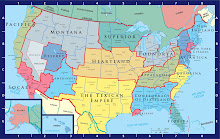(including the Nevada Territory)

AREA
647,000 sq.m. (3rd) (counting Nevada Free Zone)
POPULATION
12,933,000 (12th)
DENSITY
23 people per square mile. (17th)
CAPITAL
None (capital rotates as state capital of current president).
STATES
Lakota (Rapid City), Absaroka (Billings), Wyoming (Casper), Colorado (Denver), Montana (Helena), Idaho (Boise), Lincoln (Spokane), Oregon (Bend), Sierra (Susanville)
RELIGION
Protestant, various
LANGUAGE
English, various
NATL INCOME
620 billion
MEDIAN INCOME
$47,963 (12th)
ECONOMY
Montana’s economy is generally weak. With the exception of the Denver-Boulder metropolitan area, none of its cities are competitive internationally. It is not a member nation of the American Northeast Trade Union, preferring to maintain its staunch independence. Montana trades almost exclusively with Heartland, meaning that many goods not grown in those two nations (like saltwater fish, citrus, and wine) are often highly expensive. Montana does have enough coal, gas and mining resources to support itself and to export to a certain degree. Years of firmly minarchist government and the trading situation have contributed to a highly Spartan lifestyle; however, the government unofficially tolerates international smuggling in its unorganized Nevada territory. The cost of living is low.
OVERVIEW
Montana is a country rich in land and resources, but weak on the international stage. Built from many of the least populous states of the former USA, and landlocked and covered in many areas by the at times impassable Rocky Mountains, Montana has positioned itself as a staunchly libertarian society, with a very small federal government and no fixed national capital. Federal elections are held every three years with no possibility of a second term, and the national capital temporarily becomes the capital of the state the president has been elected from. A period of environmental conservation led by the Mountain Party presidencies of Cecil Andrus (Idaho) and Gary Hart (Colorado) was followed by a movement towards greater internationalism after the Redivision of 1994. President Richard Cheney (Mountain Party, Wyoming) sought a stronger centralized government and control of formerly federal military bases at Cheyenne Mountain, as well as involvement in the developing conflict between Atlantica and Texico (on the Texican side). A decentralist backlash saw the next three elections dominated by increasingly minarchist presidencies, concluding with a `night watchman’ state under Richard Mowell (Constitution Party, Lakota), a former Sheriff chosen by lottery. This experiment in governing led to a drastically weakened economy, and the Constitution Party was roundly defeated in the latest election by businessman Peter Coors, running on the promise to make Montana a stronger economic presence.
HEAD OF STATE

President Peter Coors,
Mountain Party

Vice President Dirk Kempthorne,
Mountain Party

No comments:
Post a Comment